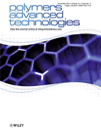Composites of poly (dimethylsiloxane) and spherically shaped poly (2-hydroxyethylmethacrylate) particles for biomedical use
Abstract
Silicone rubbers have shown considerable promise in the biomedical field, but their hydrophobicity leads to serious problems in long-term implants. In our study, composites of poly (dimethylsiloxane) (PDMS) and spherically shaped poly (2-hydroxyethylmethacrylate) (PHEMA) microparticles were prepared. Unlike previous silicone hydrogel composites, suspension polymerization was carried out in an aqueous medium to prepare PHEMA particles directly, which avoided the removal of organic phase and give hydrogel particles with high purity. Very fine PHEMA particles with uniform geometry and small size were obtained through various influencing factors during their formation. Through the introduction of PHEMA particles, PDMS matrix was endowed with hydrophilicity to a certain extent. With an increase in hydrogel content, higher swelling ability and surface wettability of the composites were observed. We have also demonstrated that smaller sized particles are more favorable for hydrophilicity improvement. The results of improved swelling ability, surface wettability, and low affinity to lipid show that this composite material is suitable for biomedical use. Copyright © 2009 John Wiley & Sons, Ltd.




